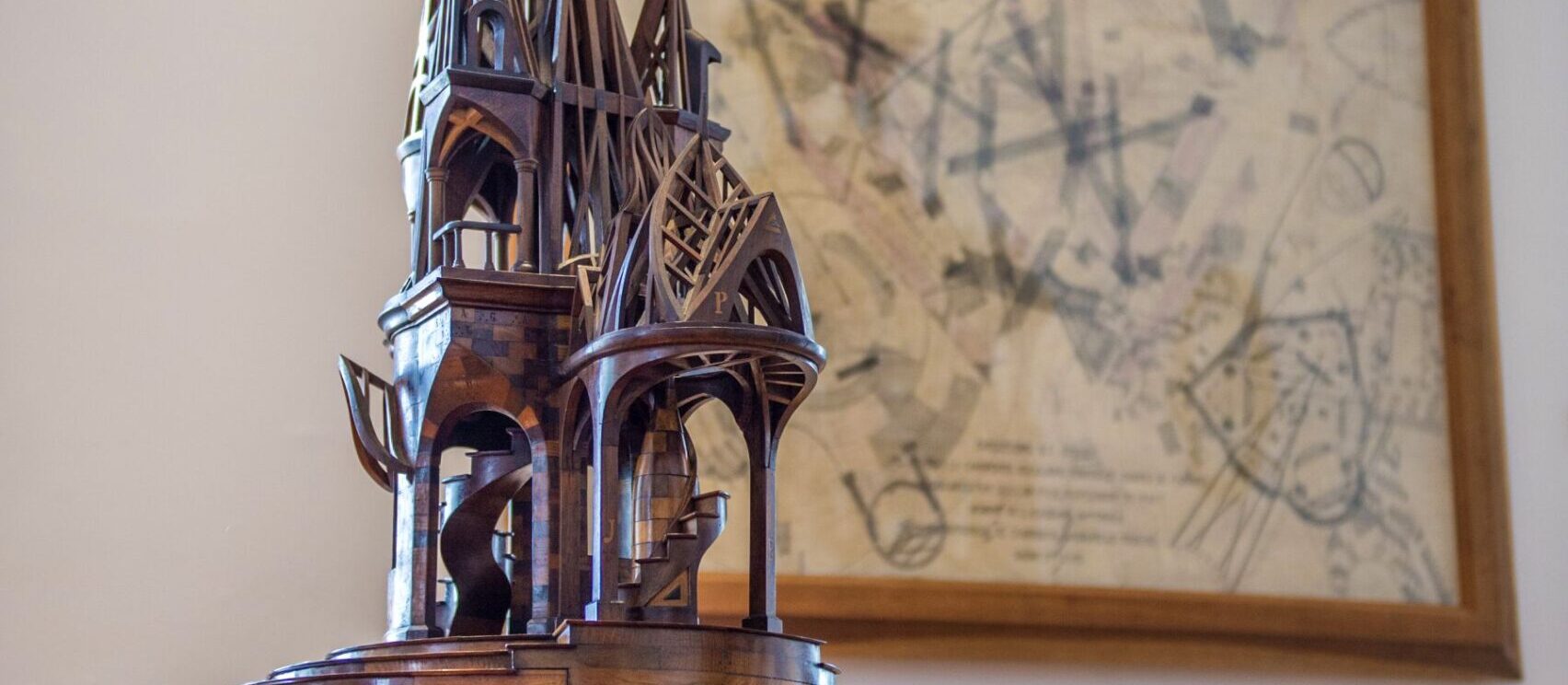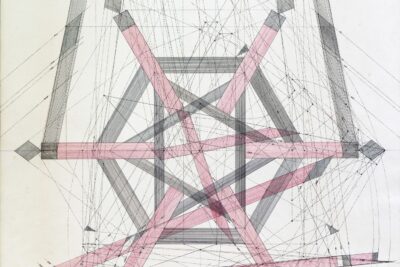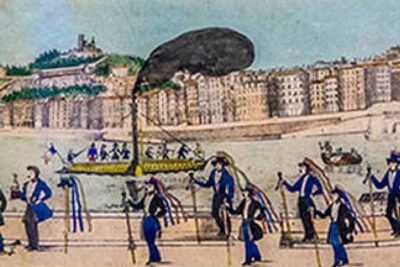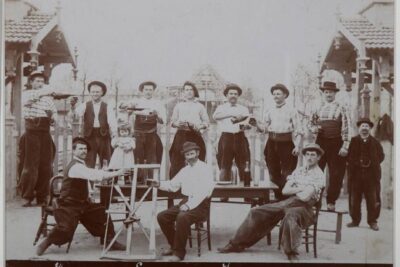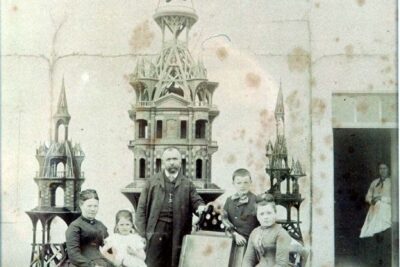English page
Publié le
The museum explains the concept of special guilds for the building and construction trades, by showcasing the collection of Pierre-François Guillon (1848-1923), a Master carpenter of the guild known as “The Duty of Freedom”.
Pierre-François Guillon founded a school for construction design arts in 1871 in Romanèche-Thorins. There he taught the scribing tradition in timber framing and stone work to apprentices, from all over France and from abroad, for 52 years.
In 2009, the scribing tradition in french timber framing was inscribed on the Representative List of the Intangible Cultural Heritage of Humanity by UNESCO
After Guillon’s death in 1923, his son Osiris donated his father’s masterworks, all the documents and souvenirs of his life as a Master, and all of the School’s students’ documents and models to the department of Saône-et-Loire.
The original museum was built in 1928. In 1994, the General Council of the department of Saône-et-Loire had the old museum renovated, and added some new rooms for the permanent and temporary exhibits. The exhibit space is used to display the extensive Guillon collection, which has been expanded through donations, bequests, and acquisitions.
Audio guides are available in french, english, dutch and German.
Closed every mondays
January 2 – april 30 : 2 p.m. to 6 p.m.
Closed May 1st
May 2 – September 30 : 10 a.m. to 6 p.m.
October 1st – December 14 : 2 p.m. to 6 p.m.
December 15 – January 1st : Closed
Admission
Full price :
Adult : 6 €
Child aged 6 to 17 : 3€
Reduced price :
Adult and student aged 18 to 26 : 4€
Child : 2€
Groups of 10 or more for self-guided tours, Essentials, Atout Beaujolais, Cezam, CNAS, Tourist Office cards, PassTime.
Free admission :
Child under 6, disabled person + caregiver accompanying a visitor with a disability, Journeymen, ICOM card holders, journalists with a press card reporting on the museum.
For reduced rates and free admission, please present valid proof of identity and ID.
Information : call +33 (3) 85 35 22 02 or email museecompagonnage@saoneetloire71.fr
DEFINITION
The trade guild is an institution of vocational training. One of its requirements is that the young trainees must travel for several years in order to enrich their professional and human knowledge. This is known as the “Tour de France” (Tour of France).
After several centuries of existence, the guild continues today — now made up of 3 sections which continue to offer complete vocational training.
In each city, the young trainee is lives with the head of his guild section, who finds an employer for him. There he improves his level of technical skill. In the evenings he takes classes. After a few years, he will have to present a masterwork to an assembly of guild masters who will assess his professional and personal skills. After passing this examination, he will be accepted to the guild.
Historians date the beginning of the first trade guilds to the Middle Ages during the construction of cathedrals, monasteries and castles. Skilled workers — stone masons and carpenters — moved from site to site. They would have sought each other out to adopt a system of rules and customs for each trade.
The principal contribution of the guild, through the centuries, was to offer highly skilled labor as a result of its training system. The guild members also knew how to assess wages and appropriate working conditions — and did not hesitate to organize a strike if needed. When a member was in difficulty, his guild came to his assistance with relief funds. The trade guild succeeded in surviving the centuries, preserving its traditions and its knowledge while adapting to the changes in the working world.
The French Compagnonnage, network for on-the-job transmission of knowledge and identities, was inscribed in 2010 on the Representative List of the Intangible Cultural Heritage of Humanity by UNNESCO.
“THE DUTY OF FREEDOM” GUILD
From their very beginnings, craftsmen gathered according to their particular trades and traced their professions back to the one of the three legendary characters associated with the construction of the temple of Jerusalem in the 10th century BCE — Solomon, who commissioned the building, Master James, stonemason; and Father Soubise, head of the carpenters — to establish their identity and traditions.
Eventually, due to differences in religious opinions, two principal sections were formed: “The Duty”, supporting the Catholic confession, and “The Duty of Freedom”, which professed the freedom of personal confession.
Thus there were two sections of carpenters: the “Master Carpenters of the Duty” (from Soubise) and the “Master Carpenters of the Duty of Freedom” (from Solomon). These two companies merged in 1945 to form “The Company of the Master Carpenters of the Duties of the Tour of France,” known today as the Federated Guild of Building Trades.
Pierre-François Guillon was a Master Carpenter of “The Duty of Freedom, Child of King Solomon”. In the guild of “The Duty of Freedom,” the carpenters are known as Indians, because according to the tradition, the Master who actually worked on the construction of the Temple was called Father Indian.
PIERRE-FRANCOIS GUILLON
Pierre-François Guillon was born in Romanèche-Thorins on June 13, 1848. Son of a master carpenter, he started training with his father in 1863. After his early training, he decided to become a journeyman and had to leave Romanèche-Thorins to do his Tour of France. He was not yet 18 years old when he took to the roads on his Tour, starting on March 17, 1866.
He began in Auxerre, where he was admitted to “The Duty of Freedom” guild under the guild name “Child of Progress of Mâcon.” He then went to Paris to work on the 1867 Exposition and the seminary of Saint-Sulpice. In 1868, he went through several towns — Blois, Angers, Chenonceau, and Tours.
In 1869 he returned to his father in Romanèche-Thorins, and gave his first carpentry courses. After returning from the war in 1870, in which he had volunteered, he founded “The Practical School of Stereotomy Applied to Construction” in 1871, better known under the name of The School of Drawing. In his school Pierre-François Guillon taught contractors and public works carpenters, future architects, and many construction foremen.
Pierre-François Guillon was also mayor of Romanèche-Thorins from 1898 to 1920, dignitary freemason, and President of the Higher Council of “The Duty of Freedom.
He died in 1923.
THE SCHOOL
Pierre-François Guillon founded and directed The Professional School of Stereotomy Applied to Construction from 1871 to 1923.
Each year, twenty or so students came to learn carpentry in general, staircases in particular, stonecutting and joinery.
The School recruited students from 15 to 25 years old. The courses were offered over three years, and the students lived at the school. Their training started with the basic study of elementary assemblies. They then learned how to draw diagrams, then to execute models which were entered in a competition organized each year. The best models remained at the School and were exhibited in its museum.
THE STUDENTS
Many craftsmen and contractors of carpentry and public works attended the School of Drawing of Romanèche-Thorins. Among them :
- Victor Auclair, Child of Progress of Bourbon; architect who participated in the rebuilding of the towns of Valparaiso and Santiago in Chile.
- Marcel Ballet, Child of Progress of Bordeaux, student at the School of Drawing from 1886 to 1888, public works contractor in Bordeaux.
- François Duret, student at the School of Drawing from 1897 to 1899, President of the Chamber of Unions of Contractors of carpentry and joinery in Geneva.
- Claude Matrat, Child of Progress of Beaujolais, student at the School of Drawing from 1878 to 1879, public works contractor, builder of the Palace of Decorative Arts in Paris.
- Louis Morel, Loyalty of Dauphiné, student at the School of Drawing between 1885 and 1888, contract carpenter in Lyon.
- Raoul Thorel, Friend of the Drawing of Louviers, student at the School of Drawing from 1879 to 1880, builder of the Quays of Tancarville in Le Havre and the pavilion of the National Forestry Commission at the 1900 World’s Fair in Paris.
- Octave Veillaud, Child of Genius of Marseilles, student at the School of Drawing from 1877 to 1879, public works contractor in Marseilles.
- Elie Martinel, Child of Genius of Castres, student at the School of Drawing from 1885 to 1888, public works contractor in Madrid.


